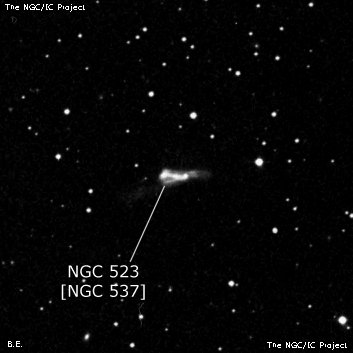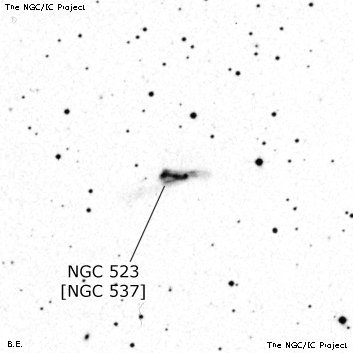NGC/IC Project Restoration Effort
(This is a very very beta version)
NGC537


Basic Information
Location and Magnitude
Right Ascension: 1:25:20.7
Declination: +34:1:31
Constellation: AND
Visual Magnitude: 12.7
Historic Information
Discoverer: Herschel W.
Year of discovery: 1784
Discovery aperture: 18.7
Observational
Summary description: Stellar (? = GC 306)
Sub-type: Sbc/P
Corwin's Notes
=====
NGC 537 = NGC 523, and the surroundings. The night of 13 September 1784 was
not a good one for WH's clock readings. With one exception (H II 224 = NGC
404), all eight objects for which he used Beta Andromedae as a comparison star
are off in RA, and -- as it has turned out -- by different amounts. In the
sweep, which I finally got to in July 2016, WH noted uncertainty in the RAs of
five of the objects (NGC 495, 496, 499, 515, and 517), and recorded transit
times for four others (NGC 515, 517, 536 and 537) only to a full minute of
time (Dreyer, as we'll see below, was well aware of all of this). In
addition, his descriptions -- with a few exceptions -- are scanty, so
identifying his nebulae has proved problematical over the years. Here is the
story, roughly in chronological order, as I first presented it years ago.
Note that Wolfgang has recently (July 2014) reanalyzed the field in light of
WH's sweeping path; a summary of his results is at the end of this note.
WH's seven questionable objects (III 167 through III 173; NGC 515, 517, 513,
523, 536, 552, and 553, respectively -- yes, NGC 513 is out of order) all
appeared in his sweep within 3 minutes of each other. Given the rush, he
determined the positions for only five of them, lumping four together into two
pairs, and treating the remaining three individually. In addition, Dreyer
(as I pointed out above) noted that WH recorded three transits -- III 167/8,
170, and 171 -- to only a full minute of time. Finally, WH himself noted the
final two as "a little doubtful." Of all this uncertainty, only that phrase
made it into WH's first catalogue of nebulae where these were presented.
JH has only five nebulae here. He claimed one (h120) to be the same as his
father's III 171, and the western of that pair (h118) to be a nova. Auwers,
and later d'Arrest, agreed with JH in making H III 171 = h 120, but noted the
difficulties in WH's RAs for some of the nebulae. d'Arrest in particular
pointed out discrepancies of about 40 seconds of time between his own RA's and
WH's in several cases, and found what he thought was a new double nebula in
the field (NGC 523).
However, while assembling the GC, JH reinterpreted the field and chose to
regard the nebulae that his father discovered as separate objects from his
own. Dreyer, too, was aware of the problem when he compiled the NGC, and
attempted to sort things out based primarily on d'A's observations. It's
clear, however, that he was a bit uncertain about the state of the field as
he wrote NGC notes for some of the objects, and commented again on all of them
in his 1912 edition of WH's Scientific Papers.
How can we make sense out of the two Herschels' observations? Let's start by
assuming that WH's nebulae are properly ordered by RA, and that their polar
distances (Declinations) are also relatively correct. Doing this, and looking
at JH's and d'A's later observations, we can make some tentative
identifications for NGC 513, 515, 517, and 536. Plotting the difference in RA
(WH minus "true") for these, we see that as the time went on, WH's RA's got
worse. Plotting a straight line through the data points, and putting a mark
at WH's RA for III 170 = NGC 537 suggests an RA correction of about 0.9
minutes of time for it. This moves the RA back to within 0.2 arcmin of NGC
523, and confirms Dreyer's suspicion in the NGC Notes that WH's number belongs
on this NGC number.
Adding this point to the plot actually suggests that the slope might be even
steeper. But what about N536 = III 171? Did WH really see that, or did he
perhaps see its brighter, higher surface brightness companion, N529, which
precedes it by about 40 seconds? (N536's two fainter companions found by Lord
Rosse, N531 and N542, have problems of their own; they have a seperate note
here under N531). Assuming WH in fact did see the western of the two objects,
we can then draw a new line through the points on the plot (this steeper
relationship suggests that WH's clock was running at about half speed, which
it, of course, was not!) in a desperate attempt to recover his final two
objects, N552 and N553. If we correct WH's RA accordingly, the position of
these two objects falls close to CGCG 502-084 and an equally bright 15th
magnitude star just west of it.
Finally, I note that -- with the exception of NGC 513, the first object in the
series -- all of WH's declinations here are 3-4 arcmin too large. Correcting
those puts his positions near enough the galaxies I've noted in the table
below. This lends a bit more support to the hypothesis I've sketched out.
In the end, then, I'm suggesting these identifications for the nebulae in the
area (the CGCG names added for verification):
RA (2000.0) Dec NGC WH JH d'A CGCG
III WH JH
01 24 26.81 +33 47 58.2 513 169 111 --- --- 521-020
01 24 38.50 +33 28 21.8 515 167 113 167 113 502-077
01 24 43.80 +33 25 46.5 517 168 114 168 114 502-079
01 25 20.76 +34 01 29.9 523=537 170 --- (Nova) 521-022
01 25 40.29 +34 42 46.8 529 171 118 --- 118 521-023
01 26 21.76 +34 42 11.1 536 --- 120 171 120 521-025
01 26 10.01 +33 24 20.5 552 172 --- --- --- --- = *
01 26 12.52 +33 24 18.5 553 173 --- --- --- 502-084
The careful reader will have already seen that the RA's for N552 and N553 are
smaller than that for N536. This adds more weight to the idea that Herschel
saw N529 rather than N536.
A postscript: Both Auwers and d'Arrest comment on WH's insecure RA's for
these objects. However, d'A apparently goes on to suggest that some of JH's
RA's are off, too. But they aren't, so I clearly need to take the time to
translate d'A's comments (that remains to be done as of July 2016).
-----
There it stood until the summer of 2014 when Wolfgang went back to CH's fair
copy of the sweep and reanalyzed it, making careful and justified assumptions
about WH's sweeping methods related to the size of his field through his
eyepiece. Rather than suggest a clock running at the wrong rate, Wolfgang
showed that the crowding of the nebulae contributed to several inexactly
recorded times. His detailed report will appear in his forthcoming book on
WH's nebulae, but his conclusions are as follows:
RA (2000.0) Dec NGC WH JH d'A CGCG
III WH JH
01 24 26.81 +33 47 58.2 513 169 111 --- --- 521-020
01 24 38.50 +33 28 21.8 515 167 113 167 113 502-077
01 24 43.80 +33 25 46.5 517 168 114 168 114 502-079
01 25 20.76 +34 01 29.9 523=537 170 --- (Nova) 521-022
01 25 40.29 +34 42 46.8 529 --- 118 --- 118 521-023
01 26 21.76 +34 42 11.1 536 171 120 171 120 521-025
01 26 57.0 +33 33 28 552 172 --- --- --- --- = *
01 27 03.0 +33 32 55 553 173 --- --- --- --- = **
Note that only two of the NGC identifications are changed from my initial
sorting out, and that only one of the WH numbers had to be moved for this
particular group of nebulae.
Wolfgang also looked closely at other of the Herschels' nebulae in the area.
I'll comment on those as needed.
Steve's Notes
=====
NGC 537
See observing notes for NGC 523.



